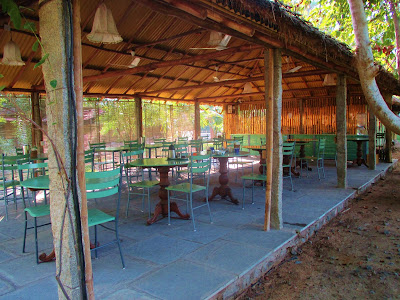We were so excited, for years Hampi had been a place of magical attraction, Lucy had been brought up with my fascination and we love the Frédéric Fougea film, Hanuman which is typical of his style with some documentary techniques and wonderful cinematography, all filmed in Hampi.
Once we were settled on the train we tried to work out which side would give the best views of the Dudhsagar waterfall, after about one hour we found out that in fact both sides gave good views as the train track was on a huge curve so we saw it from a distance and then as we went through a tunnel and over the bridge quite close up. The waterfall is on the course of the same river that flows down to Panaji, the Mandovi, it has a 310 metres drop in four tiers, at the end of the monsoon it was really a stunning sight.
After this excitement we could relax and enjoy the scenery through the Western Ghats, endless emerald paddy fields, mountains and jungle.
As we approached Hubli it was already after 8 p.m. After much thought we decided to push on to Annegundi by taxi, knowing it would take a further 3 hours. A little alarming negotiating with the taxi drivers, not simple as most didn't want to undertake the long journey there and back at that hour. Finally we found our man but we had to argue that he would be the only one coming with us, didn't fancy being in the car with two guys. Then we had to go through a rather silly pantomime of pretending to call ahead to a totally fictitious husband who was waiting anxiously and needed us to take a photo of the taxi registration.........which we did with much assurance from our driver and 6 friends that we needed to feel safe, there were still qualms but after agreeing the price of 4000 IR (52€) for 300kms we hopped in and off we went. The first 100 kms were spent with me grabbing Lucy, grabbing the front seat and quietly whimpering or actually shrieking at some points much to the amusement of Lucy and driver. I thought my hands would never un-clench again as we overtook convoys of lorries with horn blaring, whizzed through villages dodging cows, pigs and small children, speeding through the night with radio cheerfully blaring Bollywood hits. Soon I realized that our driver knew what he was doing, he was young with fast reactions, seemingly second sight and overwhelming confidence as we covered the kms with headlights blazing and horn still very active. As we reached Hospet after 3 hours I knew the agony was nearly over, we left the main road and drove at a relatively sedate pace on country lanes through amazing scenery, towering rocks and endless banana plantations. We reached Annegundi after 11 p.m., all was peaceful, was so happy to go to bed in one piece. We were staying in Peshegaar House, one of the houses in the village owned by a cultural trust http://www.urammaheritagehomes.com/uramma-cultural-residency We were met by Siraj the manager who proved to be super helpful throughout our stay, always there to answer our many questions and help us to organize our time to the best effect.
In the early morning light I explored our space and saw that although the house was ancient with some really interesting features like huge slate slab floors and ceilings, a walled garden and a covered porch, it was all beyond shabby and terribly basic, the rooms were clean but the bedding was very scanty and a bit grubby. It reminded me of early days in Morocco.
After a substantial breakfast we asked Siraj to find a guide for our first foray into the Hampi sites.
All was arranged, we were to meet Mr. Ghopal on the other side of the river and then walk along the river to the first temples. We decided to explore the village of Anegundi later as we couldn't wait to wander through the wonders of Hampi.
The walk from Uramma to the banks of the river Tungabhadra took only 10 minutes but was so wonderful, just a narrow lane through the paddy fields ablaze with marigolds, small ancient pilgrim houses were hidden among the coconut groves.
A little way from the village was another small community which we learnt later was the settlement for the untouchables, the cast system is still taken very seriously and these people were literally outcasts, their humble houses were clean and tidy with many small children coming out to see us and practice their English words. There was a humble shrine by the road with some smashed coconuts as offerings. Women were sprinkling chalk dust in precise patterns on their doorsteps to welcome any wandering deities into their homes. Cows with blue horns in honour of Shiva grazed where ever they felt like it.
We arrived at the riverbank where an old boat went backwards and forwards all day taking people, motorbikes, bicycles, goats, sheep,dogs and luggage. The boat was low in the water but it was a short distance, fabulous views while on the water to the Hanuman temple and further up the river.
We arrived safely and there was Mr. Ghopal waiting for us, a calm amiable man who proved to be an excellent guide, mixing historical fact with anecdote and even sharing some personal details which gave us insights into the Hindu religion, culture and its reaction to modern times.
We walked at a leisurely pace by the banks of the river, this was a wonderful introduction to the more spectacular splendours of the ancient city of Hampi.
PART 2 - ANCIENT HAMPI - OUR EXPLORATIONS COMING SOON!


























































































